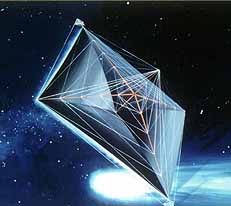Free-flying satellites powered by the Sun soar through space.
Two trials of spacecraft have successfully unfurled their solar sails, and demonstrated that radiation from sunlight can power them through interplanetary space.
Solar sails use photons from the sun to propel spacecraft at high speeds. On January 20, the small lightweight spacecraft NanoSail-D deployed a 10-square-meter gleaming sail in low-Earth orbit.
Shortly after, on January 26, engineers at the Japan Aerospace Exploration Agency (JAXA) announced the extension of their solar-sail mission IKAROS. Launched in May 2010, IKAROS flew past Venus in December last year, and the mission will continue until March 2012.
“Both of these are very good technological advances and help give confidence to solar sailing,” says Louis Friedman, executive director of the Planetary Society, a non-profit organization for space-based research based in Pasadena, Calif., that is hoping to launch its own solar sail by the end of the year.
Unlimited power
Solar sails are driven forwards when photons from the sun strike their large, thin sheets, imparting a small force. Unlike other propulsion methods, which require a spacecraft to carry fuel, the power source of a solar sail is essentially unlimited. Because they experience no friction in space, solar sails build up a great deal of thrust, and researchers hope that they could eventually be used to reach other planets or even other stars.
In contrast to IKAROS, NanoSail-D was designed to travel closer to home. Launched into low-Earth orbit, it will experience drag on the sail as it skims the planet’s upper atmosphere. Within a few months, the spacecraft should slow sufficiently to re-enter and burn up. The technology could one day be attached to decommissioned satellites to slow them down and assist in de-orbiting, says Dean Alhorn, an engineer at NASA’s Marshal Spaceflight Center in Huntsville, Ala., and principal investigator of the NanoSail-D mission.
With a sail area that extends to 200 square meters, IKAROS has made it to Venus, traveling closer to the sun in a way similar to that which allows a sailing ship to tack into the wind on Earth. Although an important milestone, the mission did not get to Venus under the power of a solar sail alone; it was launched in a trajectory that would have reached the planet with or without a solar sail, says John West, an engineer at NASA’s Jet Propulsion Laboratory in Pasadena who has worked on solar-sail technology. It did, however, show that it received some acceleration from solar photons.
The missions have shown that the solar-sail technology works and provided engineers with a great deal of data, says Alhorn. “I think we understand solar sails and how they operate much better now.”
Both space agencies are now considering the next steps for the technology. Alhorn is designing Feathersail, which would have a total sail area of 162 square meters and fly beyond low-Earth orbit. After IKAROS, JAXA plans to build a 50-meter-diameter sail that would launch in the late 2010s and cruise to Jupiter and the Trojan asteroids.










